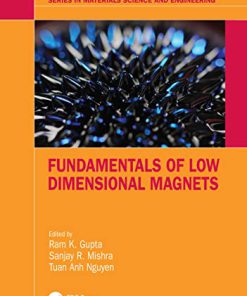Calculations and Simulations of Low Dimensional Materials Tailoring Properties for Applications 1st Edition by Ying Dai, Wei Wei, Yandong Ma, Chengwang Niu ISBN 352734909X 978-3527349098
$50.00 Original price was: $50.00.$25.00Current price is: $25.00.
Calculations and Simulations of Low Dimensional Materials Tailoring Properties for Applications 1st Edition by Ying Dai, Wei Wei, Yandong Ma, Chengwang Niu – Ebook PDF Instant Download/Delivery: 352734909X 978-3527349098
Full download Calculations and Simulations of Low Dimensional Materials Tailoring Properties for Applications 1st edition after payment

Product details:
ISBN 10: 352734909X
ISBN 13: 978-3527349098
Author: Ying Dai, Wei Wei, Yandong Ma, Chengwang Niu
Calculations and Simulations of Low-Dimensional Materials
A comprehensive guide to methods for calculating and simulating the properties of low-dimensional materials
Two-dimensional materials are those, such as graphene and 2D oxides, whose thickness is so small as to approach the atomic scale. Potential applications for these materials exist in an enormous range of scientific and industrial fields. A previous era of low-dimensional materials focused on direct experimentation to demonstrate the properties, reactions, and potential applications of these materials; however, in recent years, calculation and simulation have been shown to have considerable predictive power, reducing the period between design and deployment of these potentially critical materials.
Calculations and Simulations of Low-Dimensional Materials offers the first comprehensive survey of this exciting new approach to low-dimensional materials. It guides readers through the foundational physics and through a range of calculation and simulation methods, each with different predictive capacities. Mastery of these methods will enable readers to narrowly tailor the properties of particular materials towards real-world applications, providing confidence in the underlying mechanics and in the range of possible outcomes.
Calculations and Simulations of Low-Dimensional Materials readers will also find:
- Broad coverage of material properties, including electronic, spin, magnetic, photonic, optical, electrochemical and transport properties
- Discussion of potential applications in areas such as electronics, spintronics, and valleytronics
- Examination of further potential applications regarding quantum Hall phase, photonics, optoelectronics, multiferroic, and photocatalysis
Calculations and Simulations of Low-Dimensional Materials is a useful reference for materials scientists, electrochemists, inorganic chemists, physical chemists, photochemists, and the libraries that support these professions.
Calculations and Simulations of Low Dimensional Materials Tailoring Properties for Applications 1st Table of contents:
Preface
- Introduction to Low Dimensional Materials
- The Role of Simulations in Material Science
- Structure and Goals of the Book
Chapter 1: Introduction to Low Dimensional Materials
- Definition and Types of Low Dimensional Materials
- Historical Background and Importance
- Unique Properties of Low Dimensional Systems
- Applications in Nanotechnology and Advanced Materials
Chapter 2: Computational Methods for Simulating Low Dimensional Materials
- Overview of Computational Techniques
- Density Functional Theory (DFT) and its Applications
- Molecular Dynamics (MD) Simulations
- Tight-Binding Models and Tight-Binding Molecular Dynamics
- Quantum Monte Carlo Methods
- Hybrid Approaches in Simulations
Chapter 3: Structural and Electronic Properties of Low Dimensional Materials
- Atomic Structures and Defects in Low Dimensional Systems
- Electronic Structure and Band Gap Modulation
- Charge Carrier Dynamics in Nanomaterials
- Influence of Quantum Effects in Low Dimensions
- Graphene, Nanotubes, and 2D Materials
Chapter 4: Tailoring Mechanical Properties via Simulation
- Predicting Mechanical Strength and Flexibility
- Strain Engineering in Low Dimensional Materials
- Defect-Induced Property Modifications
- Coupling Mechanical and Electronic Properties
- Applications in Flexible Electronics and Sensors
Chapter 5: Optoelectronic Properties and Simulation Techniques
- Light-Matter Interaction in Low Dimensional Materials
- Optical Absorption, Photoluminescence, and Band Gap Engineering
- Simulation of Photovoltaic and Light Emitting Devices
- Engineering Materials for Specific Optical Applications
- Quantum Dots and Their Applications in Photonics
Chapter 6: Thermal Properties of Low Dimensional Materials
- Heat Transport Mechanisms in Low Dimensional Systems
- Thermal Conductivity and its Relation to Material Structure
- Phonon Scattering and Heat Dissipation
- Simulation of Heat Transfer in Nanostructures
- Thermal Management in Nanoelectronics and Energy Devices
Chapter 7: Magnetic Properties and Spintronics Applications
- Magnetic Behavior in Low Dimensional Materials
- Simulation of Magnetic Domains and Spin States
- Spin-Orbit Coupling and its Effects on Magnetic Properties
- Spintronic Devices and Quantum Computing
- Tailoring Magnetic Materials for Specific Spintronic Applications
Chapter 8: Interfaces and Heterostructures
- Interfacing Low Dimensional Materials with Other Materials
- Simulation of Heterostructures: Coupled Materials at the Nanoscale
- Strain and Electronic Interaction at Interfaces
- Design of Novel Heterostructures for Advanced Applications
- Applications in Electronics, Optoelectronics, and Energy Storage
Chapter 9: Low Dimensional Materials for Energy Applications
- Energy Harvesting and Storage Materials
- Simulations of Batteries and Supercapacitors at the Nanoscale
- Design of Catalysts for Energy Conversion
- Low Dimensional Materials in Solar Cells and Fuel Cells
- Computational Studies in Energy Efficiency
Chapter 10: Environmental and Health Implications
- Environmental Impact of Low Dimensional Materials
- Toxicity and Biocompatibility in Nanomaterials
- Computational Approaches to Assess Environmental Risks
- Sustainability of Low Dimensional Materials in Industrial Applications
Chapter 11: Advanced Topics in Low Dimensional Material Simulations
- Machine Learning and Artificial Intelligence in Material Simulations
- Multiscale Simulations: Linking Atomic to Macroscopic Properties
- Simulations in Manufacturing and Nanofabrication
- Challenges and Future Directions in Material Design and Simulation
Chapter 12: Conclusion: The Future of Low Dimensional Materials and Simulations
- Recap of Key Findings in Simulations and Material Tailoring
- Emerging Applications and Technologies
- The Integration of Computational Design with Experimental Techniques
- Prospects for Future Research and Development
Appendices
- A. Glossary of Computational and Material Science Terms
- B. Key Computational Tools and Software for Material Simulations
- C. Suggested Readings and Further Resources
- D. Mathematical Models and Algorithms for Simulations
References
Index
People also search for Calculations and Simulations of Low Dimensional Materials Tailoring Properties for Applications 1st :
dimensional analysis and modeling
dimensional analysis simulation
solidworks simulation large displacement
dimensional analysis method of solving problems
solidworks simulation load case manager
Tags:
Ying Dai,Wei Wei,Yandong Ma,Chengwang Niu,Low Dimensional,Tailoring Properties
You may also like…
Uncategorized
Engineering - Telecommunications
Physics - Mechanics: Strength of Materials
Uncategorized
Chemistry - Inorganic Chemistry
Earth Sciences - Hydrogeology
Medicine - Others
Disaster Medicine 1st Edition by Wei Zhonghai 1842659324 9781842659328











